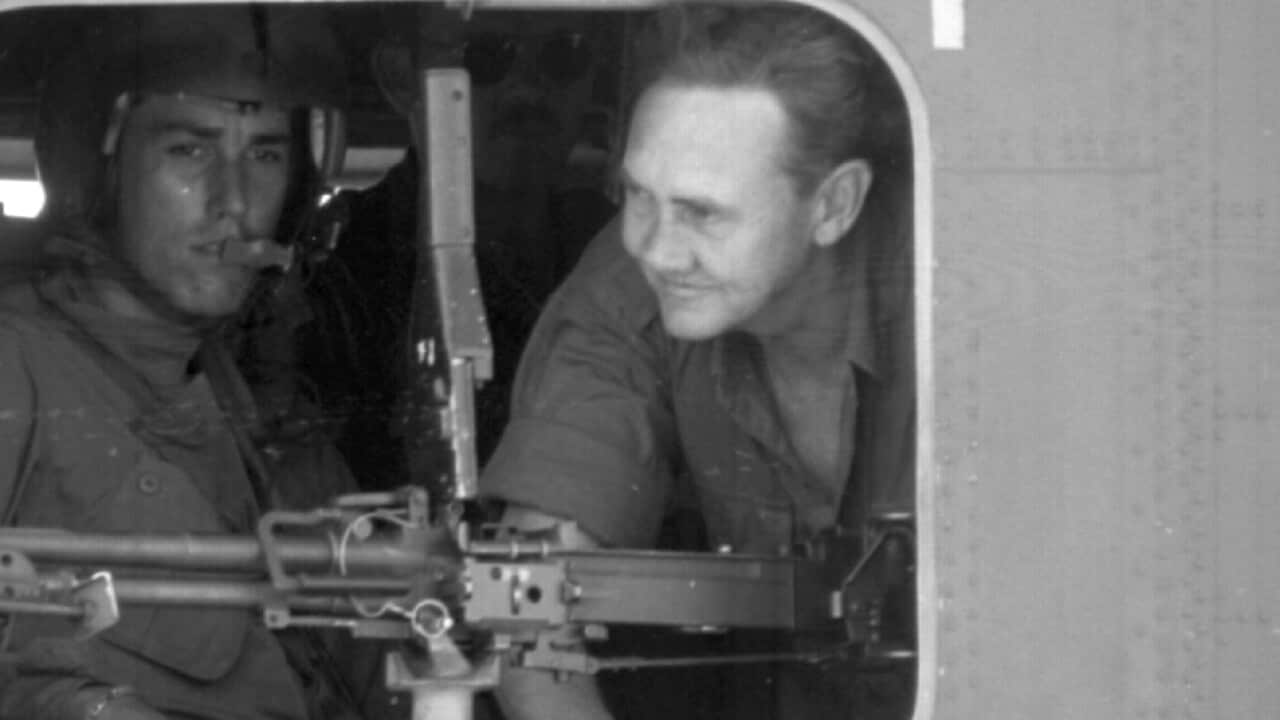Being shot down by the Japanese during World War Two was a death sentence for most pilots.
But for Sir John Grey Gorton — who, decades later, would become Australia's 19th prime minister — it was the first of several near-misses, leaving his face severely damaged.
The 29-year-old former Geelong Grammar prefect enlisted in the Royal Australian Air Force (RAAF) in 1940, after seeing the rise of fascism during his studies at Oxford University.
Following pilot training in England, Gorton was posted to Singapore as part of the No. 135 Squadron RAF, which flew Hawker Hurricane planes.

Credit: Sievers-Clary, 1941. Source: Trove, National Library of Australia
On the ground, Dutch soldiers mistook him for a Japanese fighter and opened fire, clipping his face, according to a 1985 article in the RAAF News.
"A bit later, some (rescue) fellows took a look at me, and I heard them say 'No use, he's a goner'," Gorton told the Australian Women's Weekly in April 1975, adding that they also stole his watch and wallet.
His wife Bettina, home with their three children and tending to their orchard in Victoria's northwest, was notified he was missing.
The evacuation vessel Gorton boarded a week later was torpedoed by a Japanese submarine. Dozens crammed onto a life raft designed for seven, and they floated for around 20 hours before being rescued by the HMAS Ballarat.
However, the ordeal would not deter him from serving his country and after a brief stint at home to heal, he was posted again.
Gorton survived two more incidents, a forced landing in Darwin, where he and his aircraft were missing for days and a crash landing in Milne Bay, according to the Australian War Memorial.
Upon being discharged in December 1944, Gorton underwent facial reconstruction.
"Wasn't much use crying about it," he told the Australian Women's Weekly, "If you get your face pushed in, it's pushed in."
Fighter pilot turned prime minister
After the war, Gorton turned his sights to politics, becoming a Liberal senator in 1949.
Elevated to the role of navy minister a decade later, he held other portfolios, becoming the first minister for education and science, before his time as prime minister.
Gorton started his tumultuous time in office in 1968 under unusual circumstances, having won a Liberal leadership ballot after prime minister Harold Holt disappeared while swimming at sea.
His larrikin streak initially proved quite popular with the public, with his approval rating reaching 64 per cent in April 1969.

John Gorton was known for his informal way or "Gorton" way of running government. Source: Getty / Norman James
"A knockabout bloke with the larrikin streak, his scarred features and crumpled suits, his candid approach and laconic air, jaunty grin, tousled hair and ever-present cigarette," he said.
Gorton had some conservative views; he opposed Indigenous land rights out of fear they would promote separatism and was against an Australian republic.
He was also a proponent of nuclear power, which in the Australian parliament of today is a position more aligned with the conservative side of politics.
He also had some progressive leanings, like his advocacy for centralising government power at the federal level. This, and a perception he made policy "on the run", caused friction within his party.
Gorton proposed asserting Commonwealth sovereignty over offshore waters in an attempt to protect the Great Barrier Reef from exploitation, made contributions to expanding social welfare, and supported decriminalising homosexuality.

Former prime minister Sir John Gorton with his second wife Nancy Gorton. He remarried 10 years after Bettina died. Source: Getty / Patrick Riviere
Gorton's departure from the prime ministership was as unconventional as his entry; he cast the deciding vote against himself in the 1971 no-confidence motion that saw him lose the Liberal leadership.
He resigned from the Liberal Party in 1975. As a radio commentator, he remained vocal on progressive issues like marijuana law reform.
When then prime minister John Howard attended Gorton's 90th birthday in 2001, he said: "(Gorton) was a person who above everything else was first, second and last an Australian".
Gorton died in 2002.










